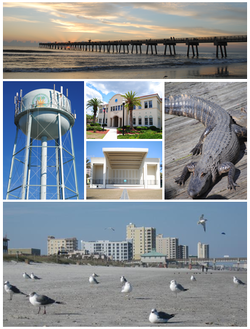Jacksonville Beach (FL)
| Jacksonville Beach, Florida | |
|---|---|
| City | |
| City of Jacksonville Beach | |

Images from top, left to right: Jacksonville Beach Pier, water tower, Jacksonville Beach City Hall, Sea Walk Pavilion, Adventure Landing, Jacksonville Beach
|
|
 Location in Duval County and the state of Florida |
|
| Coordinates: 30°17′3″N 81°23′46″W / 30.28417°N 81.39611°WCoordinates: 30°17′3″N 81°23′46″W / 30.28417°N 81.39611°W | |
| Country | United States |
| State | Florida |
| County | Duval |
| Settled | 1831 |
| Incorporated | May 22, 1907 (Pablo Beach) |
| Government | |
| • Mayor | Charlie Latham |
| Area | |
| • City | 21.96 sq mi (56.88 km2) |
| • Land | 7.33 sq mi (18.99 km2) |
| • Water | 14.63 sq mi (37.89 km2) |
| Elevation | 10 ft (3 m) |
| Population (2010) | |
| • City | 21,362 |
| • Estimate (2016) | 23,387 |
| • Density | 3,189.28/sq mi (1,231.32/km2) |
| • Metro | 1,394,624 (US: 40th) |
| Time zone | Eastern (EST) (UTC-5) |
| • Summer (DST) | EDT (UTC-4) |
| ZIP codes | 32240, 32250 |
| Area code(s) | 904 |
| FIPS code | 12-35050 |
| GNIS feature ID | 0284697 |
| Website | City of Jacksonville Beach |
Jacksonville Beach is a coastal resort city in Duval County, Florida, United States. It was incorporated on May 22, 1907 as Pablo Beach, and would later change its name to Jacksonville Beach in 1925. The city is part of group of communities collectively referred to as the Jacksonville Beaches. These communities include Mayport, Atlantic Beach, Neptune Beach, and Ponte Vedra Beach. When the city of Jacksonville consolidated with Duval County in 1968, Jacksonville Beach, together with Atlantic Beach, Neptune Beach, and Baldwin, voted to retain their own municipal governments. As a result, citizens of Jacksonville Beach are also eligible to vote in mayoral election for the City of Jacksonville. As of the 2010 census, Jacksonville Beach had a total population of 21,362.
The area around present-day Jacksonville Beach was first settled by Spanish settlers. Spanish missions were established from Mayport to St. Augustine. Spain ceded Florida to Great Britain by treaty in 1763, only to have Spain regain it again, and then a final time in 1821 to the United States. American river pilots and fishermen came to Hazard, present-day Mayport, and established a port.
In the late 19th century, developers began to see the potential in Duval County's oceanfront as a resort. In 1883 a group of investors formed the Jacksonville and Atlantic Railroad with the intention of developing a resort community that would be connected to Jacksonville by rail. The first settlers were William Edward Scull, a civil engineer and surveyor, and his wife Eleanor Kennedy Scull. They lived in a tent two blocks east of Pablo Historical Park. A second tent was the general store and post office. On August 22, 1884, Mrs. Scull was appointed postmaster. Mail was dispatched by horse and buggy up the beach to Mayport, and from there to Jacksonville by steamer. The Sculls built the first house in 1884 on their tent site. The settlement was named Ruby for their first daughter. On May 13, 1886, the town was renamed Pablo Beach after the San Pablo River. In 1885, the San Pablo Diego Beach Land Co. sold town lots ranging from $50 to $100 each along with 5 to 10 acres (2.0 to 4.0 ha) lots from $10 to $20 per acre within 3 miles (4.8 km) of the new seaside resort "Pablo Beach". In September 1892, work on the wagon road to Pablo Beach (Atlantic Boulevard) was begun. The first resort hotel called the Murray Hall Hotel was established in mid 1886 but on August 7, 1890 it was destroyed in a fire. By 1900 the railway company began to have financial difficulties and Henry Flagler took over as part of his Florida East Coast Railway. In late 1900 the railway was changed to standard gauge and was extended to Mayport.
...
Wikipedia
